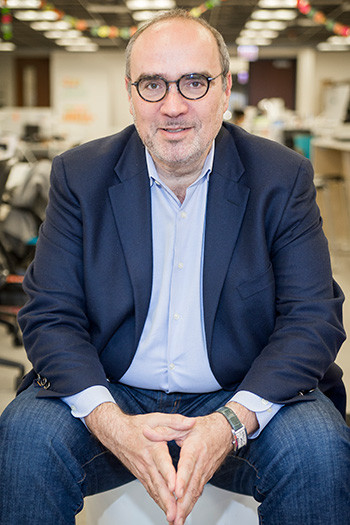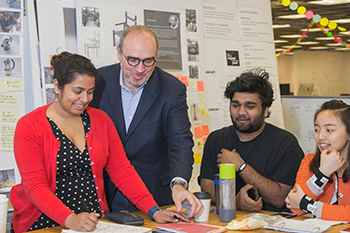
M
oving from the corporate to the public and social sectors is the most recent step in the dynamic career of ID’s newly appointed dean, Denis Weil (M.Des. ’01). This self-proclaimed “millennial in a boomer body” brings design leadership expertise gained from positions at McDonald’s, IDEO, and Procter & Gamble. From the social sector, he brings the practice of collaborating with multiple stakeholders at Year Up, Sanergy, and Mercy Corps, and the belief that design is uniquely positioned to act as catalyst and facilitator for addressing the world’s big challenges.
In 2014 you left your role as vice president of concept and design at McDonald’s for Kenya to help the social innovation start-up Sanergy scale the delivery of sustainable sanitation to people in the urban slums of Nairobi. Why the career switch?
I’ve always loved to improve man-made things and processes. As a kid I redesigned my bedroom using plan views when I was bored in school.
When I decided on my “next chapter,” I had the urge to do something different. In 2005 I taught the first service-design class at ID together with Mark Jones from IDEO, and I discovered I like complexity and being on the frontier. The more complex application of service design is design for social innovation because it has multiple stakeholders, so I built credentials in that space. For six months in Kenya, I focused on building a more human-centered design capability for franchised latrines. The Sanergy project was the strongest experience I had of a service improving the quality of people’s lives.
You’ve experienced Illinois Tech as both a graduate student and an adjunct professor. What prompted your decision to move into the dean’s role?

I have an incredible passion for design, which is truly at an intersection today. Everybody wants design, particularly design linked to innovation. But because of its success, design, and particularly design thinking, is at risk of becoming a method used by any professional practice. If that happens, then design is not a critical professional practice anymore. We are the leading school for design as a leadership practice, and we have an opportunity to redefine design.
What roles do you see design, especially ID design, playing?
Managing complexity—A good example is our Center for Collaborative Healthcare Design. A recent ID project involved redesigning an asthma discharge document that emergency room departments give to caregivers of asthmatic children. The student team reconcepted the discharge process and changed the process from a text handout to a discharge conversation guide and at-home caregiving training tool.
Directing creativity—The role of the designer is shifting from being the magician and the creative person who comes up with the creative solutions in the studio to more of a facilitator. In the health care example, we’re ideating with doctors and asking, how can we do this better?
Mobilizing action—Designers need to understand contextually the person they are trying to nudge. What kind of incentive is meaningful to that person? How do you drive behavior change? Design must and can play a major role in that.

What were the early signs of your interest in design?
I’ve always loved to improve man-made things and processes. As a kid I redesigned my bedroom using plan views when I was bored in school. Every three months I rearranged my room. Living environment was very important to me, the aesthetic aspect but also the functional aspect, such as having the minimum number of steps from my desk to my bed. Today this interest has become my passion—to increase the quotient of beauty and human dignity in everyday life. And this is what we also plan to do at ID: to expand the change we help drive in health care today to the other critical social domains of cities and food.